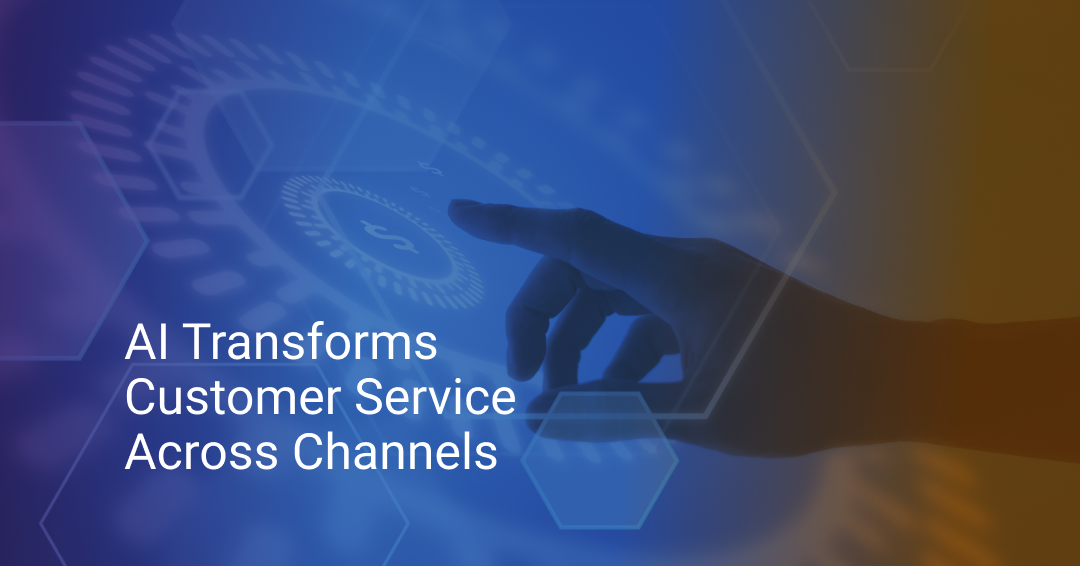7 Best Call Center Reporting Software Solutions for Your Needs
Every call is another opportunity for contact centers to gather important data on their customers. That data can reveal preferences, where customers...

Switching from chat to email to phone shouldn’t feel like starting over every time. Yet that’s often the reality of multichannel customer service when channels don’t connect.
AI systems are a big help to address this problem. They keep a history of all interactions as a single conversation. Hence, your human agents always have the full story. It makes their job easier and more efficient without the risk of slowing down their services.
The key difference lies in data sharing and continuity. A multichannel service means that you're offering support on multiple channels. But each one of those channels is isolated, so you don't really know if a customer who reached out to you had already reached out to you through another channel.
So imagine this: a customer contacts you via email regarding an order problem and then calls the following day to check on an update. The phone agent will need the customer to repeat their issue, so the interaction starts from scratch.
In contrast, an omnichannel customer service connects all channels into one single system. When that same customer calls after sending an email, the agent sees the complete interaction history and can continue where the email conversation left off.
Customers don’t stick to one way of reaching a business anymore. Some want quick answers in chat, others prefer a phone call, and plenty expect you to respond on social media. If you only offer limited options, you risk losing people who can’t connect the way they want. Here’s why offering multichannel customer service makes a difference:
As a customer, you might start a conversation on social media, follow up with an email, and then make a phone call. You're probably going to end up repeating your story at every step, getting different answers, and feeling frustrated.
Multichannel support powered by AI changes this completely. It creates a connected experience where all your channels work together instead of operating in isolation.
Your email team might have a formal tone while your chat agents are casual. Social media responses could be completely different from phone conversations.
Conversational AI solves this by creating uniform standards across all platforms. The AI stores your company's approved responses and brand guidelines in one central system. When similar questions come up on different channels, customers receive identical, accurate information. No more contradictory answers that confuse people and damage trust.
This consistency builds confidence in your brand. Customers know what to expect regardless of how they contact you.
Customers simply need their issues resolved, but traditional customer service systems address each channel in isolation. Conversational AI builds a single, comprehensive customer profile for tracking all interactions on all channels. The result is quicker resolution times and much more satisfied customers. Hence, when agents must intervene, they have full context from the start.
Customers expect quick responses, especially online. But businesses can't have staff monitoring every channel around the clock. Conversational AI fills this gap by providing instant acknowledgment and responses across all channels.
This immediate response capability is crucial for multichannel customer service success. While AI handles the quick tasks, your human team can focus on complex issues that need personal attention.
Hiring native speakers for every language and every platform becomes expensive quickly.
AI-powered systems handle multiple languages naturally without requiring separate teams. The same AI that answers English questions on chat can respond in Spanish on social media or French via email.
The quality stays consistent across languages, too. This makes multichannel support truly accessible to international customers.
AI knows when it needs to transfer calls to human agents, but this handoff includes everything. It bundles the conversation history, customer information, and what the AI has already tried. Human agents can jump right into helping without making customers repeat themselves.
Traditional customer service often creates silos because each channel operates independently. An AI system, though, breaks down these barriers to push a unified approach. It stores every customer interaction to map the entire customer's journey. Hence, you can see how customers actually use different channels and optimize your multichannel customer service strategy based on real behavior.
These are the best ways to build an effective multichannel customer service and fulfill the promise of responsive support to your customers.

Connect your platforms so conversations pick up where they left off. Nobody wants to explain their problem three times to three different people.
If someone emails about a billing issue and then calls later, your phone agent should see that email thread. This saves time for everyone and shows customers you're organized and professional.
Your team should use the same tone and follow similar response patterns across all platforms. This ensures that your brand sounds the same across channels. Customers notice when your email team is helpful, but your chat team sounds robotic.
Write templates and guidelines that work for different channels while keeping your brand voice intact. A casual brand can be friendly on social media and still professional in formal emails. Just make sure both feel authentically you.
Most customers are accustomed to using their smartphones, making it important for you to optimize your customer service for mobile devices. This includes user-friendly interfaces, responsive widgets, mobile-related features, etc.
Customer behavior patterns emerge when analyzing interactions across multiple channels. Track response times, resolution rates, and satisfaction scores for each communication platform. This data reveals which channels perform best and where improvements are needed.
Implement systems that automatically transfer conversation history, customer preferences, and issue details between channels. AI-powered platforms can summarize previous interactions and highlight key points for human agents, maintaining conversation flow regardless of channel switches. Remember that losing context forces customers to repeat information and extends resolution times.
Train your team to handle each channel separately. They need to understand how response times, tones, and platform features vary between channels. They'll need different skills for writing an email vs. chatting in real time. It's essential now for you to teach agents to use AI tools for suggestion prompts, automated responses, and conversation summaries.
AI now ties conversations across platforms. It keeps context, frees support teams from repetitive work, and keeps the multi-channel customer experience consistent. Let's dive into the top 5 platforms driving this change.
Mosaicx delivers AI-native customer service across voice, SMS, chat, and email. It brings self-service tools and data together, providing agents with the full context of each inquiry. Mosaicx particularly stands out for its flexibility to serve healthcare, retail, finance, and many other industries.
Tidio centers on live chat and AI chatbots, pulling messages from email, WhatsApp, Messenger, Instagram, and website chat into one inbox. Its Lyro AI assistant speeds up responses using GPT-4 and prebuilt flows, even showing a live preview of what customers are writing before they hit send.
LivePerson offers messaging and voice on the same platform. Its Dynamic Capacity feature automatically adjusts how many conversations agents handle, reducing wait times and keeping queues short. Additionally, live agents benefit from AI-generated summaries of ongoing chats.
Zendesk offers AI agents that reply through messaging, email, and web forms, using your own help center content. It handles translations, tags, and routes tickets, and can trigger actions in tools like Shopify or Stripe. The system also generates ticket summaries and flags tickets for agents when needed.
Ada resolves up to 83 percent of inquiries without human help. It covers chat, email, voice, and social and supports over 50 languages. The platform integrates with tools like Salesforce and Twilio, adapts to workflows, and works across enterprise setups.

Businesses have traditionally relied on various tools and their teams to handle customer interactions. This has resulted in disconnected experiences that are no longer acceptable. AI can connect and monitor multiple channels, ensuring every conversation flows seamlessly and preventing customer frustration from having to repeat themselves.
It's also not just about efficiency. Sure, automation takes care of all your routine tasks, but your business also needs a personalized effort, which conversational AI delivers. Therefore, it's a two-front approach. You're learning and adapting from your customer interactions while also building trust and loyalty via relevant, human-like engagement.

Every call is another opportunity for contact centers to gather important data on their customers. That data can reveal preferences, where customers...

Enterprises can't afford to manage their customer conversations with tools that were never designed for scale. One bad interaction is all it takes to...

The days of customer support tied to a single office are long gone. With more and more teams working across different locations and customers...